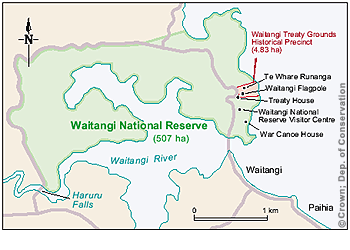Waitangi Treaty Grounds

Waitangi is the place where the Treaty of Waitangi was signed on 6 February 1840, and the site of subsequent annual commemorations of the signing.
The Waitangi National Trust Estate comprises 507 hectares, lying between the lower tidal reaches of the Waitangi River and the coastline running north to Wairoa Bay. The Waitangi Treaty Grounds Historical Precinct itself occupies 4.8 hectares within the eastern end of the estate, and includes the Treaty House, the Whare Runanga and the historic flag pole (the Maori waka, Ngatoki Matawharorua is situated close by).
War Canoe Ngatokimatawhaorua
World’s largest war canoe Ngatokimatawhaorua is believed to be the largest waka (war canoe) ever built and can carry 80 paddlers and 55 passengers. It was named after the canoe which brought the Maori people from Hawaiki and was captained by Nukutawhiti, the grandson of Kupe, the Polynesian discoverer of New Zealand. Ngatokimatawhaorua was built for the 1940 centennial celebrations of the Treaty of Waitangi and is launched every year on the 6th February, to mark the signing of the Treaty of Waitangi. At 35.7 metres long and up to 2 metres wide, it weighs 12 tonnes, and is a key attraction at the Waitangi Treaty Grounds in the Bay of Islands.
How to get there: Waitangi is an easy 3 1/2 hours drive from Auckland via Whangarei, Kawakawa, Opua & Paihia. Waitangi is located about 1 km north of Paihia.
Maori, who are Polynesians, were the first inhabitants of New Zealand, and are thought to have arrived in New Zealand more than 1000 years ago in double-hulled waka (canoe), from islands in Eastern Polynesia (Hawaiki). Maori settled on both main islands of New Zealand and named the country Aotearoa (Land of the Long White Cloud). Dutch Navigator Abel Tasman, the first European discoverer, arrived in 1642 and named the islands New Zealand. He didn’t stay, and it wasn’t until Captain James Cook arrived over a century later that the area was colonised. Late in the 18th century, Aotearoa New Zealand was settled by European missionaries and whalers. In 1840, Maori signed the Treaty of Waitangi with the British Crown, which gave the British Government sovereignty over Aotearoa New Zealand. The Treaty of Waitangi is now regarded as Aotearoa New Zealand’s founding document. The site of the Treaty signing, Waitangi in the Bay of Islands, is a national reserve of historic significance.
Official Website: www.waitangi.org.nz
More articles about: the Northland Region, New Zealand
Birthplace of a Nation
The sea, the vessel, the voyage, the arrival. New Zealand was born on the waves, from two long migrations. As a guest arriving to sail our waters, perhaps you are also destined to take a journey to Northland to discover the glorious seas and welcoming bays that cradle the Birthplace of a Nation.
To understand New Zealand today, you need to visit the place it all began and where it ends – the region that harbours the soul of a nation, and the sacred place where departing spirits leap for their own destiny.
In Maori mythology, long before the sea and land agreed on continents, Maui fished up the North Island.
Before the time of Christ, the people of Maui visited the northern lands, called Te Tai Tokerau. Around 950 A.D., the leader Kupe landed with some of his people from the distant land of Hawaiki. In the sands of the Hokianga, a vast labyrinth of inlets and estuaries on the west coast of Northland, he left his footprints.
They were to be filled years later by his grandson, Nukutawhiti, who captained the great canoe Ngatokimatawhaorua to bring the land’s first immigrants. Other great waka (canoes) came and warriors and families filtered through Te Tai Tokerau.
In 1642, Dutch explorer Abel Tasman sailed around New Zealand, but the land did not feel European footsteps until 127 years later, when British captain, James Cook came ashore.
By the beginning of the 19th century, Northland’s bays were giving shelter to sealers and whaling boats from many nations, and the Bay of Islands town of Russell became infamous as a raucous shore leave. With traders came muskets, with settlers came missionaries. With property came bloodshed and the need for agreement.
In 1840, at a place called Waitangi, the chief Hone Heke became the first of 46 to sign the founding document of bi-cultural New Zealand.
Over 500 Maori leaders followed. On that promontory above Northland’s azure bays peppered with islands, an annual ceremony marks this birth of Aotearoa, the “long white cloud” described by Cook’s crew.
A visit to the National Trust exhibition there gives a compelling insight into the birth pains that still stir in New Zealand‘s continuing formation.
It is not just the echoes of a visceral history that call you to these waters of Northland, but living songs, waiata, of a vibrant present.
Today Maori and non-Maori share the closeness of growing up together in the Birthplace of a Nation.

